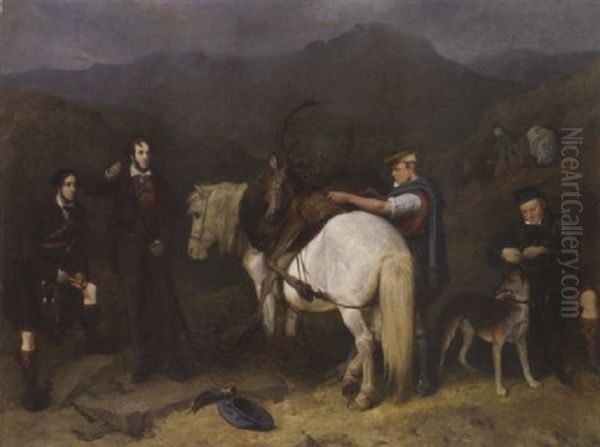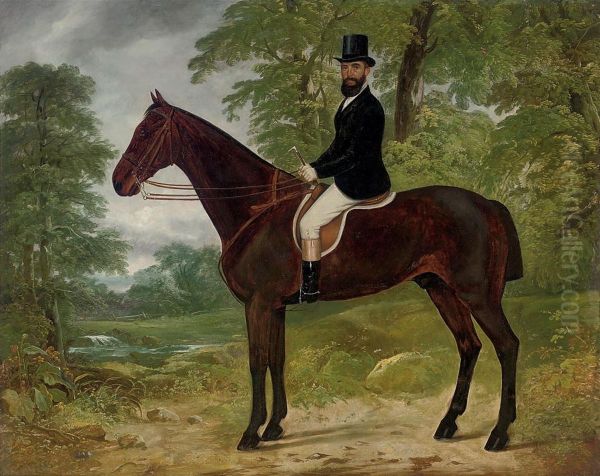Charles Hancock, a figure of the vibrant 19th century, stands as a fascinating example of the era's burgeoning connection between artistic pursuit and industrial innovation. Born in 1802 in Marlborough, Wiltshire, England, and passing away in 1877, Hancock navigated a world rapidly transforming through scientific discovery and artistic evolution. He was not merely a painter but also an inventor, leaving a dual legacy that, while perhaps not as widely celebrated as some of his contemporaries, offers a unique insight into the multifaceted talents of the Victorian age.
Early Life and Artistic Inclinations
Charles Hancock was born into a family with established roots in craftsmanship and an appreciation for the arts. His father, James Hancock, was a skilled cabinet maker, a profession demanding precision and an eye for design. Perhaps more directly influential on Charles's artistic path was his mother, Betty Hancock (née Coleman), who was herself an artist. This familial environment likely nurtured his nascent talents from a young age, providing both practical example and creative encouragement.
The young Hancock showed promise early on. A significant milestone in his burgeoning artistic career occurred when he was just nineteen years old. At this tender age, he painted a portrait of his father, James Hancock. This work was not only a personal tribute but also achieved public recognition, as it was accepted for exhibition at the prestigious Royal Academy of Arts in London. To have a work shown at the Royal Academy was, and remains, a significant achievement for any artist, and for one so young, it signaled a promising future in the art world. This early success would have undoubtedly bolstered his confidence and set the stage for his future artistic endeavors.
Beyond the portrait of his father, Charles Hancock also applied his skills to capturing the likenesses of other family members. Portraits of William Hancock and Giles Hancock are also attributed to him, suggesting a consistent engagement with this genre, at least within his personal circle. These early works demonstrate his foundational skills in observation and representation, crucial for any artist of the period.
The Equestrian Specialist: Capturing the Spirit of the Horse

While portraiture formed part of his early output, Charles Hancock became particularly renowned for his skill in animal painting, with a distinct specialization in depicting horses. In 19th-century Britain, equestrian subjects were immensely popular. Horse racing was the sport of kings and a national pastime, and the demand for accurate and spirited portrayals of celebrated racehorses and hunting scenes was high. Artists like George Stubbs had, in the previous century, elevated animal painting to a high art through his meticulous anatomical studies.
Hancock stepped into a field populated by talented contemporaries. John Frederick Herring Sr. was a dominant figure in equestrian art, famous for his detailed and lively paintings of Derby winners and farmyard scenes. James Ward brought a romantic sensibility to his animal subjects, while Sawrey Gilpin and Benjamin Marshall were also highly regarded for their sporting pictures. Hancock, too, carved out a reputation in this competitive arena. He was notably commissioned to paint portraits of Derby winners, a testament to his recognized ability to capture the power, grace, and individual character of these champion animals. Such commissions were prestigious and required not only artistic skill but also an understanding of equine anatomy and movement.
His paintings of horses would have aimed for a high degree of realism, a quality prized by patrons who often had a deep, personal connection to the animals depicted. The ability to convey the sheen of a coat, the tension of muscle, and the spirit in a horse's eye separated the competent from the celebrated. Hancock's success in securing commissions for Derby winners suggests he possessed these qualities, placing him in the esteemed company of artists who chronicled one of Britain's most beloved sporting traditions. The works of Abraham Cooper, known for battle scenes often featuring horses, and Henry Thomas Alken, prolific in hunting and coaching scenes, further illustrate the rich tapestry of equestrian art during this period, a context within which Hancock operated.
Beyond the Canvas: Invention and Industrial Enterprise
Charles Hancock's talents were not confined to the artist's studio. He possessed an inventive mind, characteristic of the Victorian era's spirit of progress and innovation. One of his notable inventions was the "odorless watercolor," a development aimed at improving the materials available to artists. The exact nature of this invention and its impact would be an interesting area for further research, but it points to his practical engagement with the chemistry and technology of his craft.

Furthermore, he patented a rubber bottle, likely connected to his work with watercolors or other artistic fluids. This foray into patenting demonstrates an entrepreneurial aspect to his character. The 19th century was a period of immense growth in the rubber industry, following Charles Goodyear's vulcanization process. Hancock's engagement with rubber, even on this scale, shows an awareness of contemporary material advancements.
His inventive and business acumen extended to a significant commercial venture. Charles, in partnership with his brother Thomas Hancock (who himself was a pivotal figure in the rubber industry, often called the "father of the British rubber industry" for his mastication process and work with vulcanization), co-founded the Westham Gutta Percha Company. Gutta-percha, a natural latex derived from the sap of trees native to Southeast Asia, was a revolutionary material in the mid-19th century. It was thermoplastic, waterproof, and an excellent electrical insulator, finding applications in everything from submarine telegraph cables to domestic goods and even golf balls.
The establishment of a company dedicated to producing gutta-percha products indicates that Charles Hancock was deeply involved in the industrial currents of his time. This dual identity as both a practicing artist and an industrial entrepreneur is particularly noteworthy. It bridges the often-perceived gap between the aesthetic and the practical, the studio and the factory. His brother, Walter Hancock, was also an inventor, known for his steam-powered road carriages, further highlighting the inventive spirit within the Hancock family.
Artistic Style and Known Works
Based on the descriptions of his work and the general artistic trends of the Victorian era, Charles Hancock's style likely emphasized realism and meticulous detail. For an artist specializing in animal portraiture, particularly of prized racehorses, anatomical accuracy would have been paramount. Patrons expected a faithful representation of their animals, capturing not just their physical likeness but also their temperament and vitality.
His training, evidenced by his early Royal Academy success, would have grounded him in the traditional techniques of oil painting. The effective use of light and shadow (chiaroscuro) to model form and create a sense of three-dimensionality would have been a key component of his skillset. The aim was often to create a "living" image on the canvas.
Among his documented works, the portraits offer specific examples:
Portrait of James Hancock (c. 1821): His early Royal Academy piece, likely demonstrating a youthful but confident handling of paint and a keen observational skill.
Portrait of William Hancock (c. 1819-1877): Described as an oil on walnut panel, measuring 60 x 45 cm. The choice of a walnut panel as a support is somewhat less common than canvas for the period but not unheard of, offering a rigid, smooth surface. This work is now in the collection of the Science Museum Group, London, a fitting home given the Hancock family's contributions to industry.
Self-Portrait (c. 1819-1877): Also an oil on walnut panel, with similar dimensions (60 x 45 cm), and housed in the Science Museum Group. The description notes him seated, dressed in dark attire, against a backdrop with a red chair and floor. Self-portraits offer invaluable insights into how artists see themselves and wish to be perceived.
While specific titles of his Derby winner paintings are not readily available in the summarized information, their existence points to a significant body of work within the sporting art genre. These paintings would have been celebrated in their time, capturing moments of triumph and the beauty of thoroughbred horses. His style in these would likely align with the detailed realism of contemporaries like John Frederick Herring Sr., though perhaps with individual nuances in composition or the rendering of atmosphere.
The broader artistic context of Victorian England saw a flourishing of various styles. The Pre-Raphaelite Brotherhood, with artists like Dante Gabriel Rossetti, John Everett Millais, and William Holman Hunt, championed intense detail and vibrant color, often with literary or moral themes. While Hancock's sporting art and portraiture differed in subject, the Victorian penchant for verisimilitude and narrative clarity was a widespread aesthetic. Even the great landscape painter J.M.W. Turner, though an earlier Romantic figure whose later work became increasingly abstract, had a profound impact on British art, as did John Constable with his naturalistic depictions of the English countryside. Portraitists like Sir Thomas Lawrence, who dominated the early part of the century, and his successor as President of the Royal Academy, Sir Martin Archer Shee, set high standards for formal portraiture. Sir Edwin Landseer, an exact contemporary of Hancock, achieved immense popularity with his animal paintings, often imbued with anthropomorphic sentimentality, a slightly different approach to Hancock's more direct sporting focus.
Legacy and Collections
Charles Hancock's contributions, though perhaps not as widely known today as some of his peers, are preserved through his artworks and the historical record of his inventive and industrial activities. The fact that his works, including family portraits, are held by the Science Museum Group in London is significant. This collection, primarily focused on science, technology, industry, and medicine, recognizes the Hancock family's broader impact, with Charles's art being presented alongside the evidence of their industrial ingenuity.
The management of his works and family history by Hancock family descendants and their partners ensures that his story and contributions are not lost to time. Museums play a crucial role in preserving such legacies, allowing future generations to study and appreciate the diverse talents of individuals like Charles Hancock. His life reflects a period when art and science were not always seen as disparate fields but could coexist and even complement each other within the pursuits of a single individual.
His dual career offers a valuable lens through which to view the Victorian era—a time of great artistic production, but also of unprecedented technological advancement and industrial expansion. Hancock embodied this duality, comfortable in the artist's studio meticulously rendering the form of a prize-winning horse, and equally engaged in the world of patents and manufacturing with materials like rubber and gutta-percha.
Conclusion: An Artist of His Time
Charles Hancock (1802-1877) was a man of diverse talents, a product of the dynamic and innovative spirit of 19th-century Britain. As an artist, he distinguished himself with his skilled depictions of horses, contributing to the rich tradition of British sporting art and gaining recognition for his portraits of Derby winners. His early success at the Royal Academy attested to his artistic capabilities from a young age.
Simultaneously, Hancock was an inventor and industrialist. His development of "odorless watercolor" and a patented rubber bottle, alongside his co-founding of the Westham Gutta Percha Company with his brother Thomas, demonstrates a keen engagement with the technological and commercial opportunities of his era. This intersection of art and industry in one individual's life provides a compelling narrative.
While he may not have achieved the towering fame of a Landseer or a Turner, Charles Hancock's career is a noteworthy example of the varied paths to success and contribution in Victorian society. His legacy, preserved in museum collections and family records, reminds us of the often-interconnected nature of creativity, whether expressed on canvas or through innovative enterprise. He remains a figure worthy of study for his skilled animal painting and his active participation in the industrial advancements that shaped the modern world.